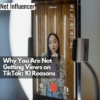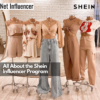Agency
CreatorIQ’s Vision For Creator Marketing: A Discussion With New CMO Brit Starr

As the newly appointed Chief Marketing Officer at CreatorIQ, Brit Starr oversees an industry where leading brands now direct more than 50% of their marketing spend toward creator partnerships. Her focus is transforming CreatorIQ’s role from software provider to essential infrastructure for brand-creator collaborations.
From Analytics to Infrastructure
Brit started exploring the creator economy while working at Tribe Dynamics, which was acquired by CreatorIQ in 2021. Her industry experience spans a shift in brand perspectives. “Eight years ago, we had to start conversations with our clients about why influencer marketing is important. And that’s not the case anymore. Now it’s ‘How can I be the best at it?’”
This transformation reflects a fundamental shift in brand-creator relationships. “Historically and initially, creators were seen as distribution channels. They’re media,” Brit notes. “You’re working with creators for their audience. And that is still true to some extent, but it’s become much richer because, at its best, you work with a community of creators. You are part of the conversation. It’s not a one-way conversation anymore.”
Recent data supports this strategic pivot. According to CreatorIQ’s latest research, “industry leaders are spending over half of their total marketing budgets on creator marketing,” Brit shares, adding that this increase comes as traditional content production struggles to meet demand. “The creative supply chain has broken down. Brands need more content than ever before. And how they get that content, it’s expensive and doesn’t work either.”
Technology Infrastructure for Creator Success
CreatorIQ combines analytics with operational tools. “We are a facilitator, an enabler, an empowerer,” Brit explains. “We don’t take a direct role in building relationships, but we are the foundation or infrastructure upon which all of that sits. The distinct role CreatorIQ is taking in is that you need real infrastructure and technology to bring creators into your entire marketing stack, consumer insight stack.”
The company’s strategic position stems from integrating Tribe Dynamics. “Tribe Dynamics has been born and raised in two philosophies. One is an earned first approach… inspiring, generating, driving conversation and content about your brand,” Brit shares. “From a product standpoint, it’s an analytics platform that helps you build strategic playbooks for growth. Prioritize those relationships, and grow in the right ways.”
This analytics foundation raises important brand strategic questions: “Do you need more people talking about you? Should they be talking about you more frequently? Do you need to consider your mix of creators regarding tiers and categories?” Brit explains. “It’s real intelligence. CreatorIQ has always been a tool for practitioners. It is the toolkit you need to operate in the creator economy.”
Enterprise Solutions and Strategic Integration
The enterprise focus of CreatorIQ presents unique opportunities. “Historically, CreatorIQ has been built to meet enterprise needs. And that can feel less sexy from a marketing and storytelling standpoint,” Brit admits.
However, she views this as an exciting creative opportunity: “Really opening my mind into truly understanding what those real needs are and how what we do adds value and being able to tell a good story around that was a unique and new challenge for me… how do you make enterprise SaaS interesting, dynamic, fun.”
The combination of analytics and operations creates what Brit describes as an essential operating system for brands entering the creator economy.
“You need real infrastructure and technology to bring creators into your entire marketing stack, consumer insight stack,” she emphasizes. “That is scalable. So you don’t have to reinvest in a patchwork of infrastructure for yourself every year as things grow and change.”
Addressing Industry Challenges
Brand Safety
Brit believes that brand safety is an “ambiguous term” that needs to be “fully realized.” The challenge intensifies “in an industry dominated by humans,” requiring solutions balancing control with authentic expression.
When Brit started in the industry, “control was still a big conversation. How do I maintain the red line?” Now, the challenge has become more nuanced: “That seamlessness to their business is so important that is safe… brand safety in an industry dominated by humans is so important.”
Measurement Standards
CreatorIQ aims to “create shared vocabulary and language across brands, agencies, creators, regions, etc., so that what has been and still is a bit Wild West can be professionalized in the way I think the industry is ready for,” Brit shares.
This standardization becomes increasingly critical as marketing budgets shift toward creator partnerships. “We saw that industry leaders are spending over half of their total marketing budgets on creator marketing, which is wild and, I think, just the beginning,” Brit notes.
AI Integration
The company develops AI capabilities for comprehensive content analysis. “What I mean by that is the ability not just to track what is written, but what is shown, what is said,” Brit explains. “Content exists in a dynamic multimodal way. And so AI allows us to catch, see, and hear more.”
This analytical capability proves crucial for brands. “Somebody could post something about Nike that doesn’t even mention it, but their logos all over it,” Brit notes. “That’s incredibly important. It will be incredibly disruptive in the content, conversation, etc., you have visibility into and how you can act against that as a brand.”
AI also enhances creator collaboration: “We’re working on using AI to automate, but also build better briefs for creators where you can show creators examples of their content that have outperformed given the outcome you’re looking to drive in that given campaign,” says Brit.
She highlights maintaining creator independence: “That’s so powerful, but it is also really respectful of what creators bring to the table, which is just context. It’s informing them to do their job better but still letting them do their job.”
Global Implementation
With creator marketing becoming increasingly international, local context matters. “Our customers are global. So, we take a truly global and localized approach that serves our customers and, again, the communities of creators they work with at that level,” Brit notes specific regional considerations: “Cultural differences, such as creator conversation, community, the way brands operate, are so important.”
The Path Forward
CreatorIQ plans to expand its community engagement. “As a company that exists and supports creator marketing, we don’t do much of that ourselves,” Brit acknowledges. The company intends to build “our community of expertise, like thought leaders in the space, whether that comes from inside our ranks, across our customers, across our community of partners.”
Traditional content creation models face increasing pressure to meet modern marketing demands. “Brands need more content than ever before,” Brit explains, “and how they get that content, it’s costly and doesn’t work as well.” She adds that this challenge drives brands to seek new solutions through creator partnerships.
Creator-generated content now takes center stage in marketing strategies as brands recognize its superior ability to engage audiences and drive results, Brit notes, adding that this represents a significant advancement from earlier approaches that viewed creators simply as distribution channels.
“The white space ahead of us as an industry – no one has done this before. We’re all at the front lines of this,” Brit concludes.





















